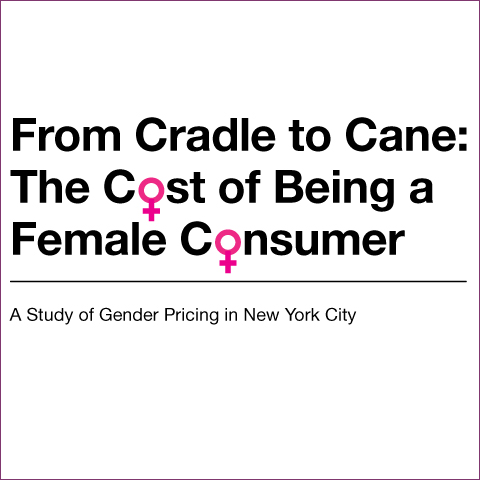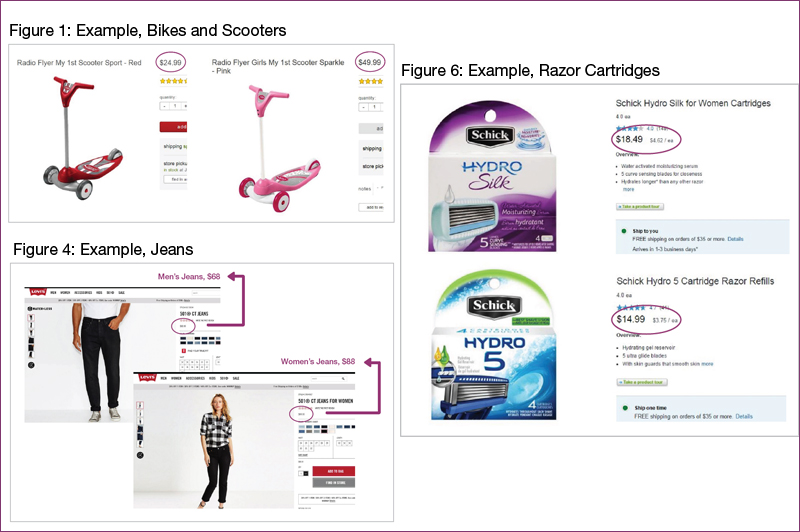
 Consumer and Worker Protection311
Consumer and Worker Protection311 Search all NYC.gov websites
Search all NYC.gov websites
From Cradle to Cane: The Cost of Being a Female Consumer
A Study of Gender Pricing in New York City

Download Full Study (in PDF)
The New York City Department of Consumer and Worker Protection (DCWP) is responsible for maintaining a fair and vibrant marketplace. To this end, DCWP conducted a first-ever study of the gender pricing of goods in New York City across multiple industries. The industries studied for this report include: toys and accessories, children’s clothing, adult clothing, personal care products, and home health care products for seniors. This study reflects an average consumer lifecycle, from baby to senior products, providing a glimpse into the experiences of consumers of all ages.
The Agency compared nearly 800 products with clear male and female versions from more than 90 brands sold at two dozen New York City retailers, both online and in stores.
Findings
On average, across all five industries, DCWP found that women’s products cost 7 percent more than similar products for men. Specifically:
Pricing Disparity Frequency Chart, All Industries
On average, across all five industries, DCWP found that women’s products cost 7 percent more than similar products for men. Specifically:
- 7 percent more for toys and accessories
- 4 percent more for children’s clothing
- 8 percent more for adult clothing
- 13 percent more for personal care products
- 8 percent more for senior/home health care products
Pricing Disparity Frequency Chart, All Industries
| Total | Number of Times |
Incidence |
| Women pay more | 168 |
42% |
| Equal | 157 |
40% |
| Men pay more | 72 |
18% |
| Total | 397 |
100% |
Examples from the Study


Impact
Over the course of a woman’s life, the financial impact of these gender-based pricing disparities is significant. In 1994, the State of California studied the issue of gender-based pricing of services and estimated that women effectively paid an annual “gender tax” of approximately $1,351 for the same services as men.12 While DCWP’s study does not estimate an annual financial impact of gender pricing for goods, the findings of this study suggest women are paying thousands of dollars more over the course of their lives to purchase similar products as men.
Over the course of a woman’s life, the financial impact of these gender-based pricing disparities is significant. In 1994, the State of California studied the issue of gender-based pricing of services and estimated that women effectively paid an annual “gender tax” of approximately $1,351 for the same services as men.12 While DCWP’s study does not estimate an annual financial impact of gender pricing for goods, the findings of this study suggest women are paying thousands of dollars more over the course of their lives to purchase similar products as men.
Though there may be legitimate drivers behind some portion of the price discrepancies unearthed in this study, these higher prices are mostly unavoidable for women. Individual consumers do not have control over the textiles or ingredients used in the products marketed to them and must make purchasing choices based only on what is available in the marketplace. As such, choices made by manufacturers and retailers result in a greater financial burden for female consumers than for male consumers.
DCWP encourages consumers to join DCWP’s social media campaign to address this issue by tweeting examples of gender pricing and fair pricing with #genderpricing.
December 18, 2015: Read the press release, City Releases Gender Pricing Study - "From Cradle To Cane: The Cost Of Being A Female Consumer"
December 18, 2015: Read Commissioner Julie Menin's Op-Ed on NY Daily News, New York City's gender tax: Goods aimed at women cost 7% more than those aimed at men; hair care products are inflated most

